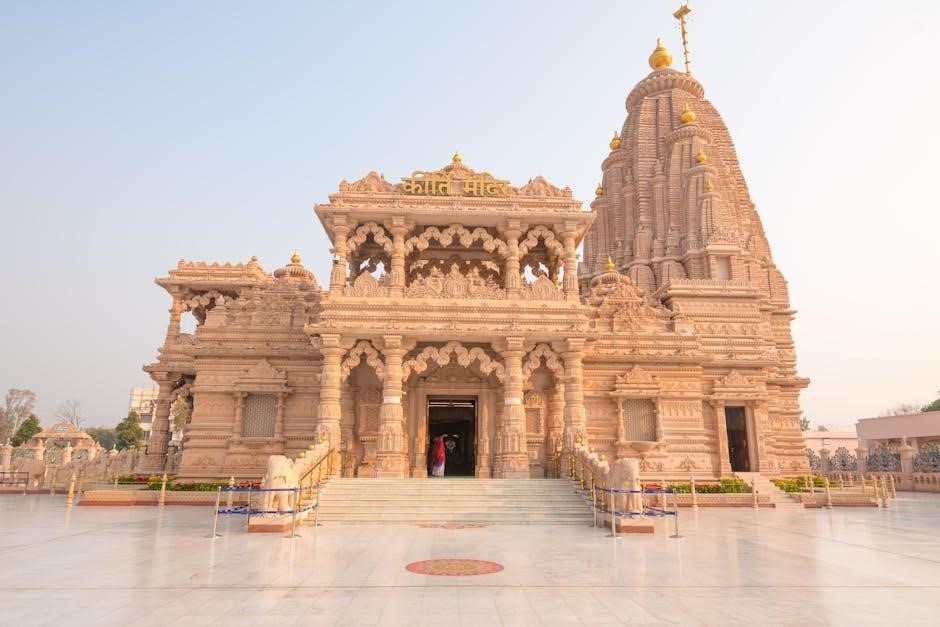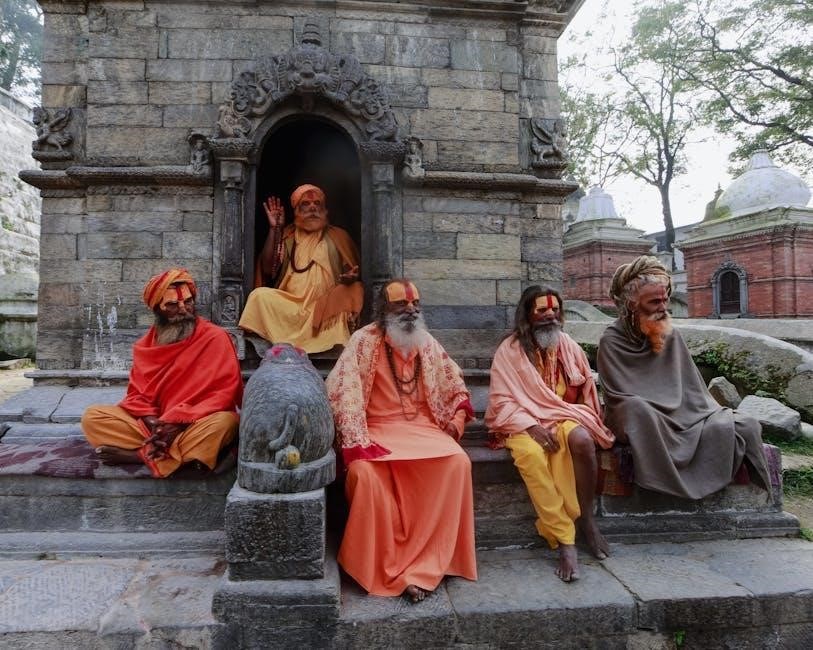
lakshmi ashtothram in sanskrit pdf
Lakshmi Ashtothram is a sacred Sanskrit hymn dedicated to Goddess Lakshmi, comprising 108 divine names that embody her virtues and blessings․ It is a powerful tool for devotion, seeking prosperity, and spiritual growth, widely recited in Hindu worship to invoke her divine grace and abundance in life․
1․1 Overview of the Lakshmi Ashtothram
Lakshmi Ashtothram is a revered Sanskrit hymn dedicated to Goddess Lakshmi, the embodiment of wealth and prosperity․ Comprising 108 sacred names, it extols her divine virtues, offering devotees a path to spiritual and material abundance․ This hymn is integral to Hindu worship, recited to invoke her blessings, ensuring prosperity and overcoming life’s challenges․ Its availability in PDF format facilitates easy access, preserving its cultural and religious significance․
1․2 Significance of the 108 Names of Lakshmi
The 108 names of Goddess Lakshmi in the Ashtothram hold profound spiritual significance, each representing her divine attributes and blessings․ These names symbolize her power to grant prosperity, peace, and spiritual growth․ Reciting them is believed to bring wealth, good fortune, and liberation from hardships, while fostering a deep connection with the divine feminine energy that Lakshmi embodies․
The Structure and Content of the Lakshmi Ashtothram
The Lakshmi Ashtothram is structured as a dialogue, listing 108 divine names of Goddess Lakshmi, each describing her virtues and blessings, followed by sacred mantras and verses invoking her grace for prosperity and fortune․
2․1 The Sanskrit Text and Its Meaning
The Lakshmi Ashtothram is a sacred Sanskrit hymn comprising 108 names of Goddess Lakshmi, each describing her divine attributes and blessings․ The text begins with a dialogue between the Goddess and Lord Mahadeva, followed by a list of names that symbolize her powers to grant prosperity, fortune, and spiritual enlightenment․ The hymn is rich in spiritual significance, emphasizing devotion and the pursuit of material and spiritual wealth․ The Sanskrit version, often available in PDF formats, includes Devanagari script and markings for proper recitation, ensuring authenticity and spiritual efficacy․
2․2 The 108 Names of Goddess Lakshmi Explained
The 108 names of Goddess Lakshmi in the Ashtothram are deeply symbolic, each representing her divine attributes and blessings․ These names, such as “Prakrityai,” “Vidyaayai,” and “Chandravadanaayai,” reflect her roles as the embodiment of nature, knowledge, and beauty․ They also signify her power to bestow wealth, prosperity, and spiritual growth․ Each name carries profound spiritual significance, making the hymn a comprehensive tribute to her divine essence․
Benefits of Reciting the Lakshmi Ashtothram
Reciting the Lakshmi Ashtothram brings spiritual and material prosperity, dispels financial struggles, and fosters inner peace․ It is believed to attract divine blessings, enhancing one’s life with abundance and harmony․
3․1 Spiritual and Material Prosperity
Reciting Lakshmi Ashtothram attracts both spiritual and material prosperity․ It enhances devotion, purifies the mind, and invites wealth, abundance, and divine grace․ Regular recitation fosters a balanced life, harmonizing inner peace with worldly success, and is a powerful means to seek Goddess Lakshmi’s blessings for a fulfilling and prosperous existence․
3․2 Overcoming Financial and Personal Obstacles
Reciting Lakshmi Ashtothram is believed to alleviate financial hardships and personal challenges․ The hymn’s divine energy helps mitigate difficulties, bringing stability and prosperity․ By invoking Goddess Lakshmi’s blessings, devotees can overcome obstacles, enhance their fortune, and find solace in times of trouble, fostering a smoother path to achieving life’s goals and personal well-being․

How to Perform the Lakshmi Ashtothram Ritual
To perform the Lakshmi Ashtothram, sit in a clean, quiet space, light a lamp, and chant the hymn with concentration․ Use a photo or idol of Lakshmi, offer flowers or sweets, and recite the 108 names with proper Sanskrit enunciation for maximum efficacy and divine blessings․
4․1 The Ideal Time and Place for Recitation
The Lakshmi Ashtothram is best recited during early morning hours (Brahma Muhurta) or evening (Pradosha time) for maximum spiritual benefits․ Choose a clean, quiet, and sacred space, such as a home altar or temple, to create a conducive environment for worship․ Sitting facing east or north is recommended to enhance focus and divine connection during the recitation of the hymn․
4․2 The Role of Faith and Concentration
Faith and concentration are paramount during the recitation of Lakshmi Ashtothram․ A sincere and focused mind ensures the ritual’s effectiveness, enhancing spiritual connection and material prosperity․ Devotees must approach the hymn with unwavering belief in Goddess Lakshmi’s divine grace, as true faith amplifies the positive energies emitted during the recitation․ Even a single recitation with pure intent can yield profound benefits, making mindfulness and devotion essential components of the practice;
The Sanskrit PDF Version of Lakshmi Ashtothram
The Lakshmi Ashtothram Sanskrit PDF is a meticulously crafted document featuring the 108 divine names of Goddess Lakshmi in Devanagari script, ideal for recitation and spiritual practice․
5․1 Features of the PDF Document
The Lakshmi Ashtothram PDF document is meticulously prepared in Devanagari script, featuring the 108 divine names of Goddess Lakshmi․ It includes transliteration guides, making it accessible for learners․ The document is free to download from trusted sources like sanskritdocuments․org and is designed for personal study and worship․ Volunteers ensure its accuracy and cultural authenticity, preserving the essence of the sacred hymn․
5․2 How to Download the Lakshmi Ashtothram PDF
To download the Lakshmi Ashtothram PDF, visit trusted sources like sanskritdocuments․org or vaidikaviganam․org․ The document is freely available and can be accessed in Devanagari script with proper anusvaras․ Ensure authenticity by selecting reliable platforms․ The PDF is easy to download and includes the Sanskrit text, transliterations, and meanings, making it a valuable resource for devotees and learners alike․
The Cultural and Religious Significance
Goddess Lakshmi embodies prosperity, wealth, and fortune in Hinduism, revered as a symbol of divine grace and abundance․ The Lakshmi Ashtothram reflects her cultural and spiritual importance, often chanted during festivals and rituals to invoke her blessings and maintain harmony in life․
6․1 Goddess Lakshmi in Hindu Mythology
Goddess Lakshmi, the consort of Lord Vishnu, is a central deity in Hindu mythology, symbolizing wealth, prosperity, and divine grace․ Emerging from the primordial ocean of milk, she embodies good fortune and purity․ Worshiped in various forms, Lakshmi is often depicted with four arms, holding a lotus, symbolizing spiritual growth and material abundance․ Her significance is celebrated in scriptures like the Vedas and Puranas, reinforcing her role in maintaining cosmic harmony and bestowing blessings upon devotees․
6․2 The Role of Ashtothram in Hindu Worship
Ashtothram, a devotional practice, involves chanting 108 sacred names of a deity, expressing deep reverence and seeking blessings․ In Hindu worship, it is a powerful medium to connect with the divine, fostering spiritual growth and material prosperity․ The recitation of these names, often accompanied by rituals, is believed to purify the mind, bring harmony, and invoke divine grace, making it an integral part of Hindu religious ceremonies and daily prayers․

The Language and Script of the Lakshmi Ashtothram
The Lakshmi Ashtothram is written in Sanskrit, a sacred language in Hinduism, and typically presented in the Devanagari script, preserving its spiritual and phonetic authenticity․
7․1 The Use of Sanskrit in the Hymn
The Lakshmi Ashtothram is composed in Sanskrit, a language revered for its purity and spiritual significance in Hinduism․ Sanskrit’s precise phonetics and rhythmic structure make it ideal for mantra recitation, ensuring the hymn’s vibrational efficacy․ The text begins with invocations like “Om Prakrityai Namah” and includes names such as “Prasaadaabhimukhyai” and “Vidyaayai,” highlighting Goddess Lakshmi’s divine attributes and blessings․
7․2 Understanding the Devanagari Script
The Lakshmi Ashtothram is often written in the Devanagari script, which is sacred in Hindu scriptures․ This script, with its distinct symbols and anusvaras, preserves the hymn’s authenticity and spiritual potency․ Volunteers and scholars meticulously prepare the text, ensuring correct markings and pronunciation guides, making it accessible for personal study and recitation while maintaining its traditional essence and linguistic integrity for devotees worldwide․

The Role of Lakshmi Ashtothram in Daily Life
The Lakshmi Ashtothram is a powerful hymn that, when recited daily, brings positivity, prosperity, and harmony to one’s life, fostering spiritual growth and familial well-being․
8․1 Incorporating the Hymn into Daily Prayers
Incorporating Lakshmi Ashtothram into daily prayers enhances spiritual routines, fostering a sense of gratitude and devotion․ Reciting the hymn during morning or evening prayers attracts positivity, prosperity, and peace․ It helps individuals connect with Goddess Lakshmi, seeking her blessings for wealth, harmony, and spiritual growth․ Regular recitation also strengthens focus and mindfulness, making it a meaningful practice for daily life․
8․2 The Impact on Personal and Family Life
Reciting Lakshmi Ashtothram fosters prosperity, harmony, and peace in personal and family life․ It cultivates gratitude, positivity, and a sense of contentment, strengthening relationships․ The hymn’s divine vibrations create a supportive environment, promoting emotional well-being and unity among family members․ Regular recitation also enhances spiritual growth, balancing material wealth with inner peace and fostering a holistic approach to life․
The Historical and Spiritual Context
Lakshmi Ashtothram originates from ancient Vedic and Puranic texts, reflecting deep spiritual traditions․ Its Sanskrit roots emphasize devotion and the pursuit of divine grace, embodying timeless wisdom and faith․
9;1 The Origins of the Lakshmi Ashtothram
The Lakshmi Ashtothram traces its origins to ancient Vedic and Puranic texts, rooted in Hindu spirituality․ It is part of the aShTottarashatanAmAvalI tradition, with 108 names of Lakshmi, and is written in Sanskrit using the Devanagari script․ The hymn is attributed to Lord Shiva, who revealed the names in a dialogue with Goddess Lakshmi, emphasizing her divine qualities and significance in Hindu worship․ Prepared by volunteers, it remains a vital part of Hindu liturgy and cultural heritage․
9․2 The Influence of Vedic and Puranic Texts
The Lakshmi Ashtothram is deeply rooted in Vedic and Puranic wisdom, reflecting ancient spiritual and philosophical traditions․ Its structure, with 108 names, aligns with the sacred significance of the number in Hindu culture, as emphasized in Vedic texts․ The hymn draws from Puranic narratives, celebrating Lakshmi’s divine attributes and her role in bestowing prosperity, making it a revered component of Hindu devotion and liturgy․

The Availability of the Lakshmi Ashtothram PDF
The Lakshmi Ashtothram PDF is easily accessible online, available for free download from trusted sources like sanskritdocuments․org and other Hindu religious websites, ensuring convenient access for devotees worldwide․
10․1 Reliable Sources for Download
Reliable sources for downloading the Lakshmi Ashtothram PDF include trusted websites like sanskritdocuments․org and Vaidika Vignanam․ These platforms offer authentic, high-quality versions of the hymn in both Sanskrit and translated formats․ Additionally, other Hindu religious and cultural websites provide free access to the PDF, ensuring easy availability for devotees seeking to incorporate the hymn into their spiritual practices․
10․2 The Importance of Authenticity
Authenticity ensures the spiritual potency and accuracy of the Lakshmi Ashtothram․ Downloading from trusted sources guarantees the hymn’s integrity, preserving its sacredness and cultural significance․ Inauthentic versions may contain errors, diluting its spiritual impact․ Authenticity fosters trust and confidence, enabling devotees to fully realize the blessings of Goddess Lakshmi through sincere recitation and worship․
11․1 The Enduring Relevance of the Lakshmi Ashtothram
The Lakshmi Ashtothram remains a timeless spiritual guide, offering devotion, prosperity, and peace․ Its 108 names of Goddess Lakshmi resonate with universal values, making it a cherished hymn for generations․ It bridges tradition and modern life, fostering a deeper connection to divine grace and inspiring seekers of both material and spiritual fulfillment across diverse cultures and time․
11․2 Encouraging the Practice of Recitation
Regular recitation of the Lakshmi Ashtothram fosters spiritual growth, material prosperity, and inner peace․ By embracing this practice, devotees connect deeply with Goddess Lakshmi, experiencing her divine grace․ The availability of the Sanskrit PDF version makes it accessible for everyone to incorporate this sacred hymn into daily worship, ensuring its timeless wisdom continues to inspire and uplift future generations․